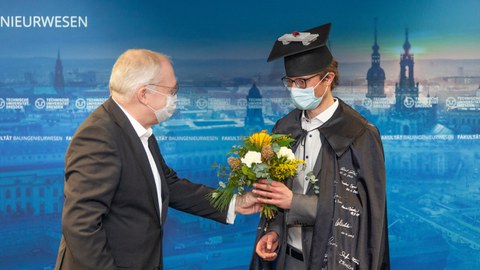Dec 14, 2021
Promotion Oliver Steinbock
On 14.12.2021, Mr Oliver Steinbock successfully defended his scientific thesis within the framework of the doctoral procedure with the topic "Reinforcement of reinforced and prestressed concrete bridges with carbon concrete".
In the field of bridge construction and civil engineering, textile concrete reinforcements have only been used in a few isolated cases so far, whereas some reinforcement measures have already been implemented in building construction. The restriction to structural engineering was due on the one hand to the material properties of the reinforcement materials available on the market and on the other hand to open questions about the load-bearing behaviour.
Due to the outdoor location of bridges, higher demands are placed on the components of the reinforcement measure compared to an indoor application. In connection with recent research projects, new textile reinforcements have been developed (e.g. carbon reinforcements in the research project C³ - Carbon Concrete Composite), which can also be used in bridge construction due to their temperature resistance. In contrast to the usual building construction, bridges are not predominantly subject to static loads and are thus exposed to high fatigue stress. The present work takes up the special aspects of the bridge stock in Germany in order to present the application possibilities of reinforcement measures with textile or carbon concrete. The focus of the work was first of all to work out the deficits of existing solid bridges. Due to increased utilisation requirements, an ageing bridge stock often requires bending reinforcement. In connection with increasing traffic loads and volumes, a possible fatigue of the supporting In connection with increasing traffic loads and volumes, possible fatigue of the supporting structures should also be mentioned, which affects both steel and prestressed concrete bridges.
Cracked coupling joints, but in particular the problem of stress corrosion cracking in historical prestressing steels, on the other hand, are a special feature of prestressed concrete construction. Against this background, a comparison between established strengthening methods for solid bridges and strengthening with carbon concrete was discussed. In order to be able to evaluate the applicability of carbon concrete as a strengthening measure, aspects of the material properties were first compiled on the basis of current research projects and supplemented by a targeted series of tests. The focus of the work was on investigating the load-bearing behaviour of reinforced and prestressed concrete structures. While at the beginning of the work there were already findings on the load-bearing behaviour of textile-reinforced reinforced concrete structures in the fracture state, there was only little information available on the load-bearing behaviour of textile-reinforced reinforced concrete structures.
Post-reinforced components are mixed-reinforced components. While the bond differences between the reinforcement material in the old concrete component and the subsequently applied reinforcement layer are of minor importance in the fracture state, they significantly determine the load-bearing behaviour in the service state. In prestressed concrete construction, the differences in In prestressed concrete construction, the differences in the composite behaviour are taken into account with the redistribution factor η, whereby a correction of the tensile force components in the reinforcement elements takes place with different composite properties. First approaches for the redistribution of the tensile force components in textile-reinforced reinforced concrete structures were formulated by [Weiland 2009], which were taken up again in the context of the present work and investigated experimentally. Specifically, various 4-point bending tests were carried out on carbon concrete reinforced steel and prestressed concrete slab strips. For the reinforced concrete slabs, both ribbed and plain reinforcing steels were used, whereas the prestressed components were reinforced with strands in immediate bond. The aim of the investigation was to determine the magnitude of the tensile force components in the metallic reinforcement elements over the length of the component and to record them with the aid of fibre-optic measuring systems in order to determine the unloading effect to validate the relieving effect for the old concrete component as a result of the subsequent reinforcement layer. In addition, it was possible to derive a design approach for the ultimate limit state of prestressed concrete structures subsequently reinforced with textile concrete. The widespread problem in Germany of reinforcing structures with prestressing steel that is susceptible to stress corrosion cracking was also dealt with in the context of the work. The danger of sudden failure due to unnoticed prestressing steel failure can be prevented by applying a strengthening measure. Experimental investigations were carried out on bridge girders from a deconstructed bridge. The girders were first selectively damaged, then reinforced with carbon concrete and the load-bearing behaviour evaluated with regard to the criteria of crack formation under service loads (announcement behaviour) and the achievable residual safety (load-bearing safety).
The results and calculation approaches were compiled in a design example for practical application. This thesis has thus created the basis for designing reinforcement measures with carbon concrete in bridge construction.
In addition to the chairman of the doctoral committee, Prof. Dr.-Ing. habil. Ivo Herle (TU Dresden), Prof. Dr.-Ing. Dr.-Ing. E.h. Manfred Curbach (TU Dresden) and Prof. Dr. Thomas Bösche (Dresden University of Applied Sciences (HTW)) were present as reviewers.
Dresden (HTW)) were present. Prof. Holger Svensson (TU Dresden) was also present as a member of the doctoral committee.
Another expert, MR Prof. Dr. Gero Marzahn (Federal Ministry of Transport and Digital Infrastructure, Head of the Bridge and Civil Engineering Division), was connected via video conference.
We warmly congratulate Oliver Steinbock on completing his doctorate and wish him all the best and every success for the future.

